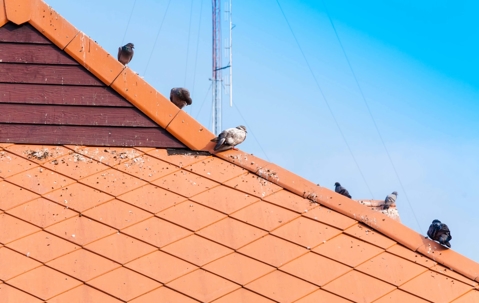Bird Deterrent and Bird Control Spikes
Effective or Eyesore Bird Control Measure?
Are you fed up with bird droppings or just can't stand the constant racket? You might be wondering if bird spikes can help you with bird control.
The good news is that bird control spikes can keep birds off your property. You don't need to wait for a roof replacement to deter birds! Bird spikes are a nearly 100 percent effective, maintenance-free, and long-lasting method of bird control. They offer a variety of benefits, which we'll address below.
So, continue reading to learn more about bird spikes and how they can protect your roof and property.
What Are Bird Spikes?
Bird spikes are a humane and effective deterrent to prevent birds from landing or roosting on specific surfaces. These spikes discourage birds from making your property their home by creating an uneven and uncomfortable landing surface.
Though spiky, they are not intended to hurt or impale birds. Instead, they rely on the bird's natural avoidance of anything that may harm them to keep them away from the area. Most bird spikes are not sharp enough to harm birds that may attempt to land on them, but they are strong enough to make landing difficult and uncomfortable.
The spikes are usually made of high-quality plastic or metal with a flexible base and come in various sizes and shapes. They can be purchased in pre-made strips or as single spikes that can be placed along ledges, rooftops, gutters, and any other area where birds are known to roost or nest.
Do Spikes Stop Birds From Roosting & Nesting?
Yes, bird spikes can prevent large birds from roosting and nesting. Before we dive into the specifics, let's clarify the difference between the two and how bird spikes can deter both behaviors.
The Difference Between Roosting and Nesting
While both involve birds seeking shelter and safety, roosting and nesting serve distinct purposes:
- Roosting. Birds roost to rest and sleep, often in communal groups. Birds will roost in areas where they feel safe from raccoons and other predators, often on ledges, roof peaks, or trees.
- Nesting. Birds nest to raise their young. They construct nests using various materials like twigs, leaves, and feathers. When it comes to your roof and home, birds often nest under eaves. These bird nests are usually made of twigs, leaves, and other materials, which can damage the property and create a health hazard for humans.
How Bird Spikes Deter Roosing and Nesting
Bird spikes create an uncomfortable and inhospitable surface, making it difficult for birds to land and perch. Bird spikes deter roosting and nesting, preventing birds from settling in unwanted areas.
The Right Kind Of Spikes For You
There are various bird spikes on the market, but we recommend using plastic or metal spikes that are blunted or curved at the ends to protect the birds from harm. The spikes are usually made of plastic or metal and can be purchased in various colors.
Be careful of brands that aren't curved at the ends, as you don't want to worry about retrieving injured birds from your roof. Curved spikes are still effective in deterring pest birds from landing and roosting.
Metal Bird Spikes
Metal bird spikes are usually made of aluminum or stainless steel base and can last for many years with proper care and maintenance, making a great permanent solution to bird problems.
These narrow aluminum or stainless-steel bird spikes also have the benefit of being much less visible than alternative materials.
Plastic Bird Deterrent Spikes
Plastic bird spikes are cost-effective but need to be replaced more often. Both types of spikes are effective in deterring birds from landing and roosting on your property.
Metal spikes may be a better investment if you stay in your home long-term and live in a temperate area where birds gather year-round. However, if you only deal with birds a few months a year and deal with severe weather conditions for a part of the year, plastic base spikes may be a better option because they are cheaper to replace, won’t rust or corrode, and are easier to remove and store.
The main difference between metal and plastic spikes is the price, with metal being more expensive. Bird deterrent spikes are often called Pigeon spikes. These spikes are especially effective as a deterrent for pigeons, but they will also work for most bird species, squirrels, and other climbing animals that could cause damage to your home.
Why Should You Use Bird Spikes?
Bird spikes can be helpful for several reasons, including:
- Protect Your Property. Birds can cause significant damage to your roof. Bird spikes can protect your property from dropping stains, erosion from acidic waste, and damage from nests.
- Improve Hygiene. Bird droppings can carry harmful bacteria and parasites, posing health risks to humans and pets. Additionally, they can attract pests like flies and rodents.
- Prevent Nesting. Spikes deter birds from building nests, reducing mess and potential damage. Bird nests can clog gutters and damage parts of your roof.
- Keep Pets Safe. Predatory birds like hawks and owls can threaten smaller pets like cats and dogs. Bird spikes can help protect your pets by preventing these birds from perching or hunting in your yard.
Pro Tip: Do you need help washing your roof? Visit our blog on how to clean roof shingles to learn more!
Bird spikes will not be effective against every bird; however, they will be helpful for most. If you have a bird problem, these spikes may be the long-term solution you need.
Where To Use Bird Spikes?
Bird prevention spikes can be installed on ledges, roof peaks, gutters, signs, window sills, and other areas where birds perch.
The spikes should have a flexible base, be placed close together, about 6 inches apart, and be installed at 2-3 inches deep. This will make it difficult or impossible for birds to land and roost without harming them because their average leg length is less than 3-4 inches.
In some cases, bird spikes spaced too far apart can make it easier for smaller birds to build a nest because the spikes hold the fibers together. Make sure to ask your local roofing contractors what they recommend.
Use Bird Spikes On These 5 Common Bird Roosting Surfaces
Do you see birds but aren't sure where they’re nesting? We’ll discuss a few common areas where you can place bird spikes, netting, or other anti-bird measures. Look for sheltered and stable locations, which help birds protect their eggs and young chicks from the elements and predators.
These locations are all prime areas to place bird spikes to deter roosting or nesting behaviors:
- Curved surfaces, like tree branches or the walls of a nest box, provide good roosting sites for birds.
- Flat surfaces, like the top of a fence post or windowsill, are popular bird roosting spots.
- Roof peak vents, turbine vents, and other rooftop protrusions offer birds good roosting sites during inclement weather.
- Both narrow and wide ledges offer protection and rest for birds, so it's a good idea to cover any ledges with spikes.
- Birds also nest on pipes, signs, docks, and underneath roof eaves.
In addition to these main roosting surfaces, birds will also use man-made structures, such as power lines, building ledges, and clotheslines, as roosting sites.
Any surface on which a bird can perch and feel safe from predators can be a roosting site. If you want to remove all birds from your property, you may want to limit access to these types of surfaces.
Do Bird Spikes Work for Small Birds?
No, bird spikes don't work for small birds. They can encourage small birds to roost on your roof because they can fit between the spikes. Spikes can also resemble twigs and branches. If you're dealing with smaller birds, consider these alternative methods:
- Shiny Objects. Apply foil and pie pans near areas where small birds tend to gather. The movement and glare can scare them away.
- Bird Gel. This sticky substance is unpleasant for small and large birds to land on. Apply it to surfaces where birds frequently perch. Bird gel will not poison or trap birds, roof rats, or other wildlife.
- Bird Netting. Install netting over areas where small birds like to nest or roost. Make sure the netting is fine enough to prevent birds from getting caught.
Bird Spike Installation Tips & Who to Call
Bird-repellent spikes are easy to install and maintain and effectively keep birds at bay for extended periods. They can be installed with adhesive, screws, or nails.
We recommend using adhesive for a quick and easy installation. But you may need to use screws or nails if the surface is not smooth or if the spikes need to be installed in a high-traffic area. Depending on the type of roofing material you have, anti-bird spikes may damage the surface when removed, so be sure to check with the manufacturer and consult a roofing contractor before installation.
Do you need help installing bird spikes or have questions about whether plastic or stainless-steel bird deterrent spikes are best for you? Contact a pest control professional. A professional will be able to assess your situation and recommend the best bird spike kit and course of action to keep birds away from your property.


